You are reading the older HTML site
Positive Feedback ISSUE 2
august/september 2002
Sunier on Hi-Res, part 2
(John Sunier, long-time audiophile journalist and reviewer, has been a member of the Positive Feedback community for ten years. As editor of Audiophile Audition (www.audaud.com) and an "Editor of the Round Table," John and company will be contributing to PF Online by allowing the use of his and fellow audaud.com contributors' hi-res audio reviews.)
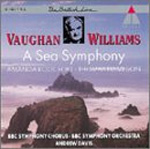
Vaughan Williams, A Sea Symphony
Christine Goerke, Soprano/Brett Polegato, Baritone/Atlanta Symphony Orchestra and
Chorus/Robert Spano, Conductor/Norman MacKenzie, ASO Director of Choruses
Telarc multichannel SACD-60588
Robert Shaw started the building process of developing the Atlanta Symphony Orchestra into a world-class ensemble; their Grammy awards under the late maestro offer a testament to a growing mastery of the choral repertory (Shaw's forte). The orchestra continued its growth under Yoel Levi's baton, who, despite an often tempestuous relationship with orchestra management, recorded numerous well-received releases over the next ten years. But I have to admit when Robert Spano was named as the ASO's new music director, I was somewhat underwhelmed, if not a little skeptical of his conducting abilities. This disc has allayed all my concerns and proves that maestro Spano indeed possesses a great understanding of a diverse repertory.
A Sea Symphony represents Robert Spano's second release for Telarc since becoming the music director for the Atlanta Symphony, and it's the first recording of a Vaughan Williams symphony by an American orchestra led by an American conductor. The multichannel SACD offers superb sonics, and the performance rates alongside the best recordings available. I really never expected Spano's version to compete with my personal favorites, Sir Adrian Boult (on EMI) or Bryden Thomson (on Chandos), but this recording places him among elite company.
Vaughan Williams' first symphony is almost more cantata than symphony; his brilliant choral settings of texts by Walt Whitman provide extensive work for the chorus and soloists. Baritone Brett Polegato performs admirably, but the real star here is soprano Christine Goerke—her singing is breathtaking throughout, and will serve as a great test of your system's resolving abilities. High points are the first and fourth movements; midway through the fourth, "The Explorers," baritone and soprano combine with various solo instruments and build into an orchestral climax of intense power and majesty.
Telarc gives us a reference multichannel SACD with this disc—a superb recording, no gimmicky surrounds, just lots of ambience and hall information—the way I think most of us would have SACD done. Robert Spano proves that the ASO is still a force to be reckoned with—the future looks quite bright indeed. Tom Gibbs
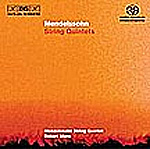
Mendelssohn, String Quintets (complete)
Mendelssohn String Quartet: Miriam Fried, violin; Nicholas Mann, violin; Ulrich
Eichenauer, viola; Marcy Rosen, cello; with Robert Mann, viola II
BIS multichannel SACD - BIS-SACD-1254
The Mendelssohn String Quintets are quintessential chamber music, as indispensable as anything from the pens of Beethoven or Schubert. That said, I was really looking forward to hearing this multichannel SACD from BIS, and it does not disappoint!
The Mendelssohn Quartet plays with aplomb aplenty. Robert Mann, founding member and fifty-plus year member of the Julliard Quartet provides the second viola, and his playing here is just superb. The allegros are played with speed and finesse, and the scherzo of the Quintet No. 1 is masterfully acquitted. The real beauty of each quintet, however, is revealed in the slow, inner movements. Overall, the playing is really exquisite and nearly, if not truly, definitive for each of the works included.
The sound of the multichannel SACD is reference quality—it places the instrumentation in front of the listener with plenty of ambience and hall information. The instruments are well separated and spread across the soundstage. Recent DVD-As from Tacet that I've heard experiment with placing the five instruments alone in each of the channels, and while placing the listener among the players works reasonably well, the approach that BIS has taken here works and sounds magnificent!
I would place this disc at or near the top of my collection of classical, or for that matter, all multichannel SACDs. If you can't find this disc in stores, get it at www.qualiton.com. Another fabulous SACD from BIS, with hopefully many more to come! Tom Gibbs
The battle of the hi-res and non-hi-res, stereo and multichannel Pictures...
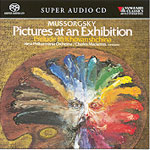
Mussorgsky, Pictures at an Exhibition
Prelude to Khovanshchina, New Philharmonia Orch./Charles Mackerras
Vanguard Classics multichannel SACD, VSD 509
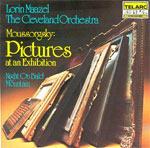
Mussorgsky, Pictures at an Exhibition
Night on Bald Mountain, The Cleveland Orchestra/Lorin Maazel
Telarc stereo SACD-60042
Have a look at the xrcd reviews in this issue for yet another Pictures. The two here are both SACD but the first is four-channel - a product of the quad years, taped in l973—and the second just two. The age of the original Vanguard certainly doesn't show in this case. Mackerras' tempi are faster than Reiner's on the xrcd, and there is a more flowing interpretation throughout. The very involving surround mix places the listener in the center of the orchestra—right up on the podium. As with the chamber music DVD-A recordings from Tacet, this may be a gimmick but it really does involve one in the music more deeply. The low bass hits in the score come thru deeper and with more impact than either of the other Pictures versions. The orchestra seems further away in front than on either of the two other versions, but the feeling of involvement minimizes this.
Telarc's SACD is one of their series of several from early in their existence, when they pioneered use of the Soundstream 50K digital recording system. The conversion to DSD was accomplished with a dCS Sample Rate Converter with custom software. The higher sampling rate improvement is subtle but hearable, similar to the higher of the two DAT sampling rates: 48K vs. the CD standard of 44.1K. Maazel also achieves a more flowing interpretation than Reiner, but since these are supposed to be discrete pictures that one promenades past and looks at, perhaps that is not really appropriate. In general this is a more workmanlike treatment than the others. The brass playing here isn't as good as on the other two versions, and the sonics are surprisingly not quite as open sounding as the other two either. So if you don't have SACD playback capability yet, I suggest the Reiner xrcd version, and if you do have it get the Vanguard. John Sunier
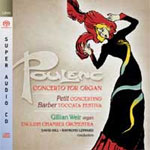
Poulenc, Concerto for Organ
PETIT: Concertino; BARBER: Toccata Festiva - Dame Gillian Weir, organ/English Chamber
Orchestra/David Hill (in Poulenc) & Raymond Leppard, conductors
Linn Records multichannel SACD CKD 180
This gets my vote as the best classical disc of the month, and one of the three or four very best SACD discs yet. The Poulenc organ concerto is the only 20th century work for that combination of forces that has a place in the standard repertory. Poulenc reported that the work was the most difficult he had ever penned, but his efforts have given us one of the most exciting concertos for any instrument. Basically a Romantic work, the concerto makes some bows in the direction of Bach, Mozart and Tchaikovsky and mixes the composer's irresistible French joie de vivre with passages of deeply affecting emotional content. His tunes are soaring and inspiring, but with very modern harmonic trappings. As in his liturgical choral works, he seems to be able to successfully blend devout and serious spiritual expression with sophisticated and sensual melodies and harmonies. Weir is a fabulous soloist, and the involving surround puts you in the chapel where the recording was made. There is strong vertical component to the organ reproduction, as heard on the Michael Murray Telarc CD of the Jongen organ concerto. Pierre Petit was a music critic at Le Figaro but also wrote many different works. His concerto is almost as long as the Poulenc and recalls the style of Roussel. The short Barber work provides a celebratory conclusion to the program of this gem of a surround SACD. I give this five stars. John Sunier
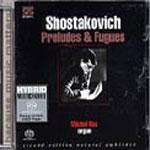
Shostakovich, 24 Preludes And Fugues, Op. 87
Michiel Ras, organ
STS Digital multichannel SACD 611130
This Dutch production was made in close cooperation with Philips and Marantz Europe, who are headquartered in Holland. Five Schoeps mikes were used for the five-channel Pyramix System DSD recording, using Ed Meitner's convertors. The recording engineer gets two pages in the booklet to talk about his approach to recording these works. The site was the RC Bartholomeus Church in Zevenbergen, which has a rich acoustic. The philosophy of recording was to bring the atmosphere of the venue to the listener by retaining the ambience. This meant micing at more distance from the organ pipes. As a result, in silences between tracks you can hear the sound of the pneumatic pump and at times the action of the organ itself. The idea is for the softer passages to float in the church's ambience but for the climaxes to never blow one away.
Sonically the production is entirely successful, and the listener can concentrate on the realistic feeling of sitting in the church during the performance of this cycle of preludes and fugues inspired by Bach's original. Normally heard on the piano (Keith Jarrett has one of the best versions out), organist Ras decided that not only were the works flexible for different keyboards (as were Bach's) but some even sounded better on the organ than the piano. There were many decisions to be made regarding registrations—which of course are not used with the piano. The process was like orchestrating Shostakovich's piano works—selecting the appropriate timbres for each voice or section. There are more than 300 changes of register on the SACD, and very few edits were made in an effort to preserve the flow of the performances. John Sunier

Beethoven, Symphony No. 6 in F Major "Pastorale", Respighi, The
Pines of Rome
New Jersey Symphony Orch./Zdenek Macal
Aix Records DVD-A & V AIX 80006
Rather odd bedfellows here, but an interesting hi-res disc in many ways. Recorded at the New Jersey Performing Arts Center in Newark, the Pastoral Symphony gets a workmanlike delivery, with the widescreen spectacle of the Pines (although half the length of the Beethoven) receiving the more stirring performance as well as more appropriate multichannel sound. On this double-sided disc the DVD-Audio side includes both an audience-perspective surround mix as 96K/24 bits using MLP and a two-channel mix, also at 96/24, but using uncompressed PCM instead of MLP. Therefore the latter will play on any DVD-Video player whether or not it has DVD-A or DTS options. The video side contains both a 5.1 audience mix in Dolby Digital and a 5.1 "stage" mix using DTS. The complete performances both works are accompanied by full videos, and three angles may be selected - included one dubbed "Conductor Cam"—zeroing strictly on conductor Macal at the podium. Other extras include biographical and stylistic information about the composers, a commentary track on the Beethoven by Jamie Bernstein Thomas and another on the Respighi by conductor Macal, Behind-the-scenes session stills, Performer information and web connections, and a complete 5.1 system setup and checking section. John Sunier
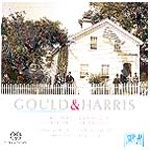
Roy Harris, Symphony No. 2 (1934), Morton Gould, Symphony No. 3 (1947)
Albany Symphony Orch./David Alan Miller
Albany Records stereo SACD TROY515
Here is a another World Premiere Recording, and this time of symphonic works by two of the major American composers of the last century - works which have not been heard by anyone for over a half century. Harris had a place near the center of America's serious music world most of his life. In some ways his spacious open-interval signature sound seemed even more "American" than his compatriot Copland. His three-movement Second Symphony was written for Serge Koussevitzky and the BSO, but for some reason Koussevitzky decided against conducting the new piece himself, the critics were aweless, and the work was neglected until its recent restoration via restoring major portions excised by Harris after the premiere and correcting 70-year-old copying errors in the parts. The first movement was inspired by Beethoven's Fifth, and the finale is full of rhythmic complexities though diatonic harmonies. Gould, who died in 1996, wrote his longest and most ambitious work in his Third Symphony, on a commission from the Dallas Symphony. The composer's sardonic humor and jazz leanings are in strong evidence in the four-movement work, which also had been modified following its initial performance, including even a different final movement. The original finale was found and substituted for this recording premiere. The CD layer of this disc is very good, but the SACD shines with a transparency that makes this first hearing of the younger works of two great American composers sound even fresher. John Sunier

John Pizzarelli with The George Shearing Quintet, The Rare Delight of You
Telarc multichannel SACD-63546
OK, I did this in our April Jazz section, so let me summarize to save you the effort of going back to that in our Archives: Pizzarelli is one of those great jazz instrumentalists who has decided to concentrate on singing. Not being a strong vocal fan I usually feel short-changed when that happens, but this album brought me around as far as Pizzarelli is concerned. Perhaps the inspired backing by the Shearing Quintet was a factor in the success of this meeting of two generations in blues. Pizzarelli has a light and loose young voice with a smile in it. And if you do an A/B comparison of the stereo CD with the multichannel SACD, you'll be smiling yourself. (This time the original CD and the CD layer of the hybrid disc sounded identical to me.) Man, this is the most! Now you're really digging the music, not just letting it bounce off you! Tracks: If Dreams Come True, The Lady's in Love with You, Everything Happens to Me, Lulu's Back in Town, Something to Remember You By, Lemon Twist, Lost April, Problem, The Rare Delight of You, Shine on Your Shoes, Indian Summer, Be Careful It's My Heart, September in the Rain, I Predict, Lucky to Be Me. John Henry
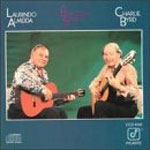
Laurindo Almeida and Charlie Byrd, Brazilian Soul
(with Milt Holland, percussion; Bob Magnusson, bass)
Concord Picante/Hi-Res Music Stereo 96K/24bit DVD-A:
The l980 gem of a duo from Concord Records was a perfect choice for the Hi-Res folks to do up in hi-res. Concord's engineer Phil Edwards gained a reputation among audiophiles for achieving superb reproduction on their LPs—though he really didn't do anything that painfully purist in recording them. Somehow things just came out right, possibly due to simplicity of approach. This was one of the label's most popular LPs and the super-clean impact of the quartet is now the best it's ever been. The styles of the two veteran Spanish guitarists are different enough to provide contrasts, yet they blend beautifully as they play off against one another. It doesn't appear either used amplification. All but two of the ten tunes have a Brazilian background; the first of those is an original by Charlie and the closer is the big tune from Evita (which sort of dates this date). Tracks: Carioca, Naquele Tempo, Cochichando, Puperce, Famoso, Choro II, Brazilian Soul, For Jeff, Don't Cry for Me Argentina. John Henry
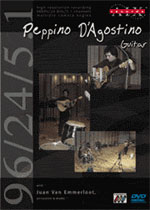
Peppino D'Agostino, acoustic guitar, with Juan van Emmerloot, percussion &
drums
AIX Records DVD-A & V AIX 80013
D'Agostino approaches the steel string guitar in a unique way, playing the frets with his left hand while creating percussion effects with his right. He also uses unconventional tunings, and this all frequently gives the impression of multiple guitars being played. The majority of the 13 tracks are his originals, with titles like "Acoustic Funk," "The Dancer," "Beyond the Dunes," etc. The disc, like all efforts from AIX, is two-sided with one side entirely multichannel DVD-Audio at 96K/24bits. This places the guitarist and percussionist up front, but with plenty of natural ambience surrounding. However, there's so much on the video side of the disc that the hi-res side seems limited by providing only music with nothing to look at! All 13 tracks are seen in live videos of the two performers, and not only that, but you can actually make use of the Angle button on your remote to change from a general long shot view to closeups.
There are also three different audio track options: a 96/24 stereo mix using uncompressed PCM, a 5.1 surround mix using Dolby Digital which places the listener in the audience similar to the surround mix on the DVD-A side, and a 5.1 surround mix using DTS but placing the listener up onstage with the performers rather than seating in the audience. The many additional extras on this side of the disc include comprehensive notes and setup information and software for DVD-ROM web connection. The music? Well, I'm not heavily into this Windham Hill guitar style myself, but for those who are this will be right up their alley. This is one disc which would be perfectly safe for an interested collector to purchase for all the video and audio features it has, without even considering the DVD-Audio side. Even if you never get the proper player and DVD-A fails in the end, you'll still have an unusual music video with excellent surround sound - especially in the DTS option. John Henry
Visit www.audaud.com where you can find 26 more titles!
